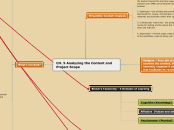CH. 5 Analyzing the Content and Project Scope
Streamline Content Analysis
1. Sustained - Design instruction around the use of conetn-laden job aids that either already exist or can be utilized by the learner beyond the learning experience. Educate and prepare your SMEs concerning the design/development process.
2. Optimized - Use existing documents, records to produce documents for review. Incorporate or review existing materials and activities rather than starting over.
3. Continuously improving - Use prototypes for SMEs to review for testing and to ensure the content is accurate, clear and relevant.
4. Right-sized - Prevent scope creep by restricting materials to the essentials; need-to-know over want-to-know.
Designer - Your job at this stage is to closely examine the content, identify what's essential, organize it and present it in a way that facilitates its review.
What's involved?
1. Gather and review the available content resources - Revisit your overall (terminal) project goals to make sure you've identified sub-goals (enabling goals). Identify what content will be included in the instruction.
If you find it difficult to find one overall goal that fits all other goals, divide the material into a curriculum or program instead of one course.
2. Identify and classify what the learner must do, know and believe to achieve each goal. Build a KASI map for the goals and sub-goals.
KASI
1. Knowledge
2. Attitudes
3. Skills
4. Interpersonal skills
Classifying the KASI helps you produce aligned instruction by helping identify valid assessments that are in line with learning outcomes, define appropriate activities and practice exercises to support learning and properly sequence the instruction and identify prerequisite entry skills and knowledge.
KAS (Knowledge, Attitudes and Skills) - More common then KASI.
Task Analysis Methods for Instructional Design by Jonassen
1. Job or Performance Analysis - Used for technical and procedural training.
2. Subject Matter Analysis or Content Analysis - Used for curriculum planning and for a subject- or topic- oriented instruction.
3. Learning or Mental Processing Analysis - Used for direct forms of instruction.
4. Cognitive Task Analysis - Used for developing instruction for problem-solving, troubleshooting and guided instruction.
5. Activity Analysis - Used to identify content related to interpersonal skills and attitudes and to define complex tasks.
UNESCO's 4 Pillars of Education
1. Learning to know
2. Learning to do
3. Learning to be
4. Learning to live together
3. Isolate essential content and prioritize - Find the essential info, divide the need-to-know from the nice-to-know and prioritize the essential info.
Ask questions such as:
Why must individuals know this, and what need is there for this learning across time and application.
What does the demonstration of learning this information look like?
What deeper levels of thinking are needed to truly demonstrate the standards included in the unit?
How can I incorporate the demonstration of those levels of thinking into the assessment?
How can I translate the standards into meaningful questions for learners?
Critical components for technical training - Steps and sequence of the task, job conditions for performing the task, the knowledge and skills required and risks involved for incorrect performance.
Critical for management development training- Content related to the culture and structure of the organization.
4. Identify and map content discrepancies and prerequisites - Map out a structure of your design by identifying the relationships between goals and the related skills.
Sequencing options to consider:
Task sequence - Present task in the order in which they should be performed.
Most critical point or task - Teach the most critical task or content first and then keep returning to it as you address the other tasks or topics.
Whole, parts, whole - Present an overview of the entire topic, then focus on each part, and finish by elaborating on the whole topic.
Simplest to most complex - Begin with the most simple components.
Known to unknown - Build on what the learner knows to teach the unknown.
Center of interest - Organize the instruction around a main point or activity and address the other topics as they relate to that main point.
Once you decide on a sequence and identify the prerequisites, graphically represent or map the concepts: content outline, flow chart, mind map or create a prototype.
5. Verify the content and scope - Have stakeholders or SMEs review your content analysis for accuracy and inclusion of only essential info. Organize info in a format that is easy for review.
Bloom's Taxonomy - 3 Domains of Learning
Cognitive (Knowledge)
Affective (Values and attitudes)
Psychomotor (Physical)
Bloom's Revised Taxonomy
LOTS (Lower order thinking skills)
Remembering, understanding, applying
HOTS (Higher order of thinking skills)
Analyzing, evaluating, creating
Ability to consider information to solve problems, analyze arguments, negotiate issues or make predictions; also known as critical and creative thinking skills.
Inform learners that the instruction is intended to foster specific higher-order thinking skills, it encourages and guides them to move beyond simple recall of facts and develop their abilities to think analytically, write critically and use knowledge to create something new.
